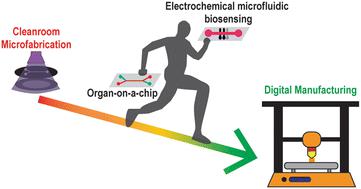Our official English website, www.x-mol.net, welcomes your
feedback! (Note: you will need to create a separate account there.)
Digital manufacturing for accelerating organ-on-a-chip dissemination and electrochemical biosensing integration
Lab on a Chip ( IF 6.1 ) Pub Date : 2022-10-28 , DOI: 10.1039/d2lc00499b Juan F Hernández-Rodríguez 1 , Miguel Ángel López 1, 2 , Daniel Rojas 1 , Alberto Escarpa 1, 2
Lab on a Chip ( IF 6.1 ) Pub Date : 2022-10-28 , DOI: 10.1039/d2lc00499b Juan F Hernández-Rodríguez 1 , Miguel Ángel López 1, 2 , Daniel Rojas 1 , Alberto Escarpa 1, 2
Affiliation

|
Organ on-a-chip (OoC) is a promising technology that aims to recapitulate human body pathophysiology in a more precise way to advance in drug development and complex disease understanding. However, the presence of OoC in biological laboratories is still limited and mainly restricted to laboratories with access to cleanroom facilities. Besides, the current analytical methods employed to extract information from the organ models are endpoint and post facto assays which makes it difficult to ensure that during the biological experiment the cell microenvironment, cellular functionality and behaviour are controlled. Hence, the integration of real-time biosensors is highly needed and requested by the OoC end-user community to provide insight into organ function and responses to stimuli. In this context, electrochemical sensors stand out due to their advantageous features like miniaturization capabilities, ease of use, automatization and high sensitivity and selectivity. Electrochemical sensors have been already successfully miniaturized and employed in other fields such as wearables and point-of-care devices. We have identified that the explanation for this issue may be, to a large extent, the accessibility to microfabrication technologies. These fields employ preferably digital manufacturing (DM), which is a more accessible microfabrication approach regardless of funding and facilities. Therefore, we envision that a paradigm shift in microfabrication that adopts DM instead of the dominating soft lithography for the in-lab microfabrication of OoC devices will contribute to the dissemination of the field and integration of the promising real-time sensing.
中文翻译:

用于加速器官芯片传播和电化学生物传感集成的数字制造
器官芯片 (OoC) 是一项很有前途的技术,旨在以更精确的方式概括人体病理生理学,以推进药物开发和复杂疾病的理解。然而,OoC 在生物实验室中的存在仍然有限,主要局限于可以使用洁净室设施的实验室。此外,目前用于从器官模型中提取信息的分析方法是端点法和事后法这使得难以确保在生物实验期间细胞微环境、细胞功能和行为得到控制。因此,OoC 最终用户社区非常需要和要求集成实时生物传感器,以深入了解器官功能和对刺激的反应。在这种情况下,电化学传感器因其小型化能力、易用性、自动化以及高灵敏度和选择性等优势而脱颖而出。电化学传感器已经成功小型化并应用于其他领域,例如可穿戴设备和医疗点设备。我们已经确定,这个问题的解释在很大程度上可能是微细加工技术的可及性。这些领域最好采用数字制造 (DM),无论资金和设施如何,这是一种更容易获得的微加工方法。因此,我们设想微加工的范式转变采用 DM 而不是主导的软光刻技术用于 OoC 设备的实验室微加工,这将有助于该领域的传播和有前途的实时传感的集成。
更新日期:2022-10-28
中文翻译:

用于加速器官芯片传播和电化学生物传感集成的数字制造
器官芯片 (OoC) 是一项很有前途的技术,旨在以更精确的方式概括人体病理生理学,以推进药物开发和复杂疾病的理解。然而,OoC 在生物实验室中的存在仍然有限,主要局限于可以使用洁净室设施的实验室。此外,目前用于从器官模型中提取信息的分析方法是端点法和事后法这使得难以确保在生物实验期间细胞微环境、细胞功能和行为得到控制。因此,OoC 最终用户社区非常需要和要求集成实时生物传感器,以深入了解器官功能和对刺激的反应。在这种情况下,电化学传感器因其小型化能力、易用性、自动化以及高灵敏度和选择性等优势而脱颖而出。电化学传感器已经成功小型化并应用于其他领域,例如可穿戴设备和医疗点设备。我们已经确定,这个问题的解释在很大程度上可能是微细加工技术的可及性。这些领域最好采用数字制造 (DM),无论资金和设施如何,这是一种更容易获得的微加工方法。因此,我们设想微加工的范式转变采用 DM 而不是主导的软光刻技术用于 OoC 设备的实验室微加工,这将有助于该领域的传播和有前途的实时传感的集成。











































 京公网安备 11010802027423号
京公网安备 11010802027423号